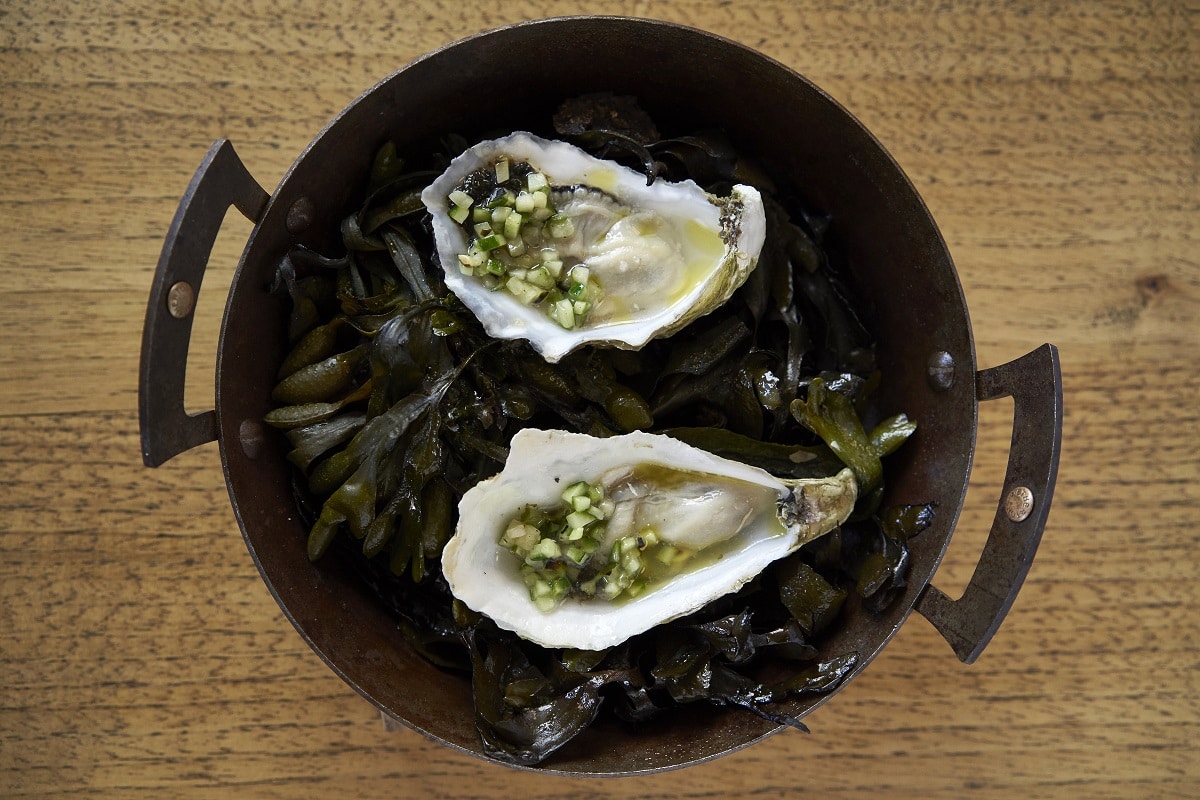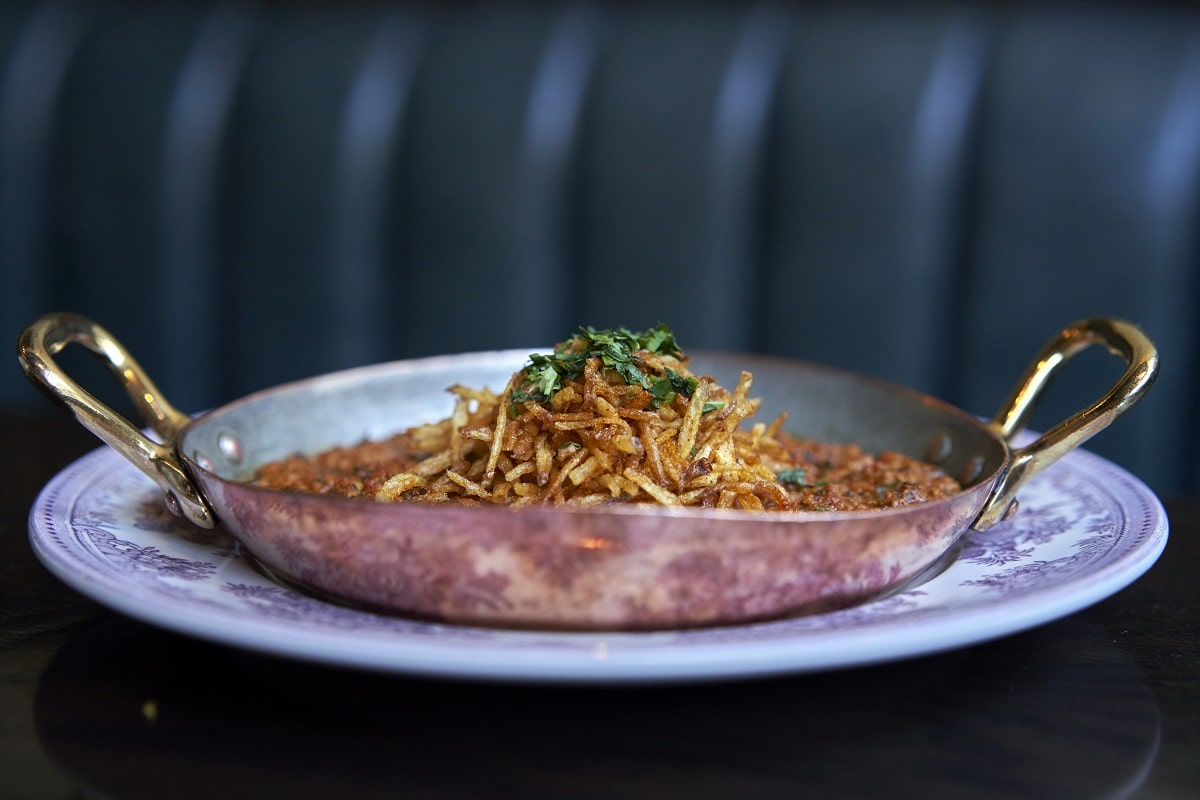Food
Beyond Porridge and Boiled Mutton: A Taste of London

Bay of Biscay, a dish of six scallops with paprika and cumin, served on a bed of seaweed and sea lettuce, at Eneko, in London.
Photo: David Azia/The New York Times
No longer can it be said that London is only a great city between meals. London’s culinary flowering is a citywide phenomenon.
As Britain — like its younger sibling across the pond — gruffly proclaims its distance from the outside world (at least for the political moment), we can all be thankful that Brexit came too late to halt the culinary globalization of London.
Put ideology aside. This otherwise noble capital inclining its palate to devotees of porridge and boiled mutton was never a thing to celebrate. Of course, a visitor could always find scattered exceptions. But it was work. The drab baseline held longer than it should have — even through the roaring ‘90s, which brought higher restaurant prices without a corresponding leap in adventurousness.
A decade had passed before I returned to London and discovered that I’d missed the revolution. No longer can it be said that London is only a great city between meals. What was once a sallow and predictable dining experience is now salubrious and full of surprises, befitting a metropolis of such diversity and ingenuity. This holds true not only in the high-rent zones of West End, Covent Garden and Soho but also — maybe even especially — in less commercialized districts to the east, such as Shoreditch and Bethnal Green. In short, London’s culinary flowering is a citywide phenomenon. For those finding fault in a cuisine that thoroughly departs from Her Majesty’s customary vittles, I refer you to Anglesea Arms and similar pub-grub bastions. And really, that’s the point: at long last in London’s restaurant scene, there’s something for everyone.
Brat
Though the Shoreditch district can be fairly accused of off-the-rails hipsterism — manifested in its avocado bar and its upscale treehouse for adults — its dining scene is fast becoming one of London’s best. The city’s latest sensation, Brat, was a mere 3 months old when I visited it in June and found it packed to capacity by 7 p.m.
The creation of wunderkind Welsh chef Tomos Parry, Brat is studiously informal, its airy second-story dining room featuring large windows that afford a view of the neighborhood’s modest brick residences and commercial hodgepodge. Parry’s small open kitchen is dominated by a charcoal grill that is in constant use. Like its patrons, Brat’s staff is uniformly young, unfussy and clever — vintage Shoreditch, in other words, but not oppressively so. For so heralded a restaurant, its daily menu is remarkably approachable. Prices for appetizers start at about $5 and entrees at roughly $22; close to two dozen wines are available by the glass. A cup of cracked salt appeared on my table without my having to beg for it. I was also grateful for the absence of locavore virtue-signaling on the menu: no names of farms; just exquisitely fresh ingredients.
My dinner was uncomplicated and also flawless, beginning with a quartet of voluptuous oysters roasted with seaweed and minced celery. I devoured them in perhaps 90 seconds, then settled into the restaurant’s unhurried cadences. The next plate — wild rabbit, blood sausage and white beans — was as close to standard English fare as I would get, with forceful but not overwhelming flavors that paired well with the glass of red from the Emilia-Romagna winemaker La Stoppa.

Oysters roasted with seaweed at Brat, in London. Photo: David Azia/The New York Times
The sun was now descending over Shoreditch, and the din inside became increasingly jovial, but well shy of raucous. My server brought me a plate of grilled asparagus with ricotta cheese, breadcrumbs and the faintest whisper of mint — far too delectable to qualify as the simple palate-cleanser I’d intended it to be. At last came the entree: a grilled pork chop from the market town of Tamworth, topped by slices of grilled peach. This was the apotheosis of simplicity’s genius. I chewed slowly, reverently. Was Brat British? Was Brat hip? No diner here could possibly care.
— Brat, 4 Redchurch St., BratRestaurant.com. Dinner for two without drinks or tips, about 120 pounds ($155)
Gymkhana
The West End neighborhood of Mayfield is not for the faint of wallet. But since its high-end boutiques and majestic squares are difficult for a tourist to resist, you might as well find a decent place to settle in for a meal after a long day of envy.
Gymkhana is considerably more than decent. It’s a 5-year-old, Michelin-starred Indian restaurant owned by three British-Indian siblings, the Sethis, who have since opened a more casual second venue in Soho. Gymkhana is, in its dignified but clubby bearing, an ode to colonial India. Crucially, however, its cuisine does not defer to the leaden palate of Olde England. Instead, its flavors are aggressive and uncompromising.
On the Thursday evening I strolled into the elegant, pub-dark restaurant, the harried waiters were quick to show me to my table and then to forget that I was there. Fully 15 minutes passed before I was rediscovered. But I was soon mollified by the arrival of a silver goblet of Jaipur India pale ale and Gymkhana’s weighty menu.
The culinary possibilities here seem innumerable, starting with several tasting menus — one of them consisting entirely of game — paired with a dazzling global assortment of wines by the glass. Given the initial slowness, I thought better of a multicourse arrangement that could last until midnight. And in any event, most of the dishes are also available a la carte.

A dish of methi keema at Gymkhana, in London, Aug. 2, 2018. London’s flourishing food scene highlights flavors from around the world. Photo: David Azia/The New York Times.
Befitting haughty Mayfair, Gymkhana isn’t cheap. But low-cost delicacies are available, beginning with the shrimp and mango chutney as well as the papadums stuffed with cassava, lentil and the palm stem extract known as sabudana. Still, you come to Gymkhana to go bold. The methi keema, a minced kid goat shoulder in a chili sauce and served with thick bread with which to make a sandwich, shattered any qualms I might have had after the slow start. The goat served as a tender vessel for the searing and complex spices which, this Tex-Mex habitué will confess, were hotter than a $2 pistol. But lordy, what a spiritual experience each bite was!
Gymkhana wasn’t through with me yet. The game-tasting menu had inspired me to finish with the wild muntjac biryani, pomegranate and mint raita — a venison dish that arrived in the form of baked bread with sesame and other seeds on top. While not nudging the pain threshold as the goat had, the venison beneath the crust was even more mysterious in its spicy elaborations (cinnamon being the one recognizable flavor). Those two dishes in tandem represent the most unforgettable Indian meal I’ve had, and I left Gymkhana confident that I had only scratched its surface.
— Gymkhana, 42 Albemarle St., +44-20-3011-5900, gymkhanaLondon.com. Dinner for two without alcohol or tips, about 120 pounds ($155)
Eneko
By happy accident, during one recent trip to London I happened to be staying at One Aldwych, a four-star hotel with much to recommend it — all, however, subordinate to its adjacent restaurant. Eneko is a Basque restaurant owned by Eneko Atxa. The location, in Covent Garden, is a high-density tourist zone replete with theaters and pub grub. Descending the staircase into the restaurant feels akin to sliding down the Batpole into a sleek, jazzy subterranean haven from all that.
Like Gymkhana, Eneko makes no culinary concessions: You’re in northern Spain. At the same time, just as the former restaurant prices its fare to Mayfair pocketbooks, the latter is a place where a theatergoer can go small if needed. It helps to begin with a glass of one of the crisp and aromatic white wines from the owner’s family vineyard, and a rock-solid charcuterie plate of chorizo, coppa, salchichón and homemade pickles. That platter, along with charcoal-smoked potatoes and stir-fried zucchini, amounts to a light and low-cost meal. For those preferring to linger, the staff is warm and knowledgeable, the menu pushing the edges of familiarity without testing the nerves.
During one of my visits to Eneko, a server recommended something the menu calls “traditional talo.” It turned out to be a large baked corn tortilla subdivided into quadrant bites covered with opulent heritage tomatoes, basil and olive emulsions, edible flowers and little caviar-like bubbles made of olive oil. In other words, a tomato salad elevated three notches.
It’s equally hard to say no to Eneko’s suckling pig tempura balls in a lascivious bacon sauce. But on my most recent outing, I gravitated to the Basque-style squid in a deep and creamy Mordorlike ink sauce. I sprang for a bottle of Catalonian orange wine fermented in amphorae, which turned out to be a fine acidic accompaniment. It lasted through the last morsel of anise-and-olive-oil bread — a splendid denouement, with only one thing missing. A convivial Spanish restaurant cries out for company. Next time, I won’t come alone.
— Eneko, 1 Aldwych, +44-20-7300-0700, eneko.london.com. Dinner for two, without drinks or tips, about 100 pounds ($129)
Sager + Wilde
There’s a casual theatricality to Michael Sager and Charlotte Wilde’s 4-year-old establishment in the East London neighborhood of Bethnal Green: arched metal ceiling, candlelit tables and wall-to-wall bar, with early-1980s New Wave music competing with the periodic rumblings of the city rail system overhead. In warmer weather, clients seem to favor the long wooden tables on the leafy patio outside. I far prefer the underground bunker allure of the dusky interior, evocative of both sanctuary and subversion.
Sager + Wilde’s namesake on Hackney Road is perhaps London’s most venerated wine bar, and that lineage was evident the moment my server plopped down the voluminous list of adult beverages alongside a comparatively stubby menu. But that’s hardly to suggest that food is beside the point here. As with Brat, the offerings here — decidedly Mediterranean — are far more about the local ingredients than about a chef’s preening.
The burrata appetizer is a case in point. Its accompaniments vary according to season — apricots, pine nuts and mint during one visit; pumpkin seeds, figs and pomegranates during another — but the marshaling of flavors is always a subtle revelation. After dispensing with the first course, I thumbed through Sager + Wilde’s eno-bible. The 250-bottle list is predominantly French, albeit with several intriguing items from Switzerland, Swartland, Iberia and even California. The manager pointed out a Cornas that he approvingly described as “a little bit wild.” Taking stock of my uncertainty, he then suggested a 2012 St. Joseph, which proved to be outstanding. It arrived alongside my pork, duck and hazelnut agnolotti, which was both velvety and robust, a fine defense against the evening’s blustery weather.
I took a long look at the pork shoulder chop, calcot onions and fennel — literally, staring at it from the next table over — before deciding that Brat had ruined me for pork and that I was nearly full anyway. With more wine to vanquish, I opted for a small and brilliant assortment of cheeses from the English countryside. Echo & the Bunnymen in one ear, the rattling of a Central Line train in another, Scottish Cheddar and Rhône red — this was exactly the London I always wanted.
— Sager + Wilde, 250 Paradise Row, sagerandwilde.com/paradise-row. Dinner for two without drinks or tips, about 65 pounds ($84)
© New York Times 2018



